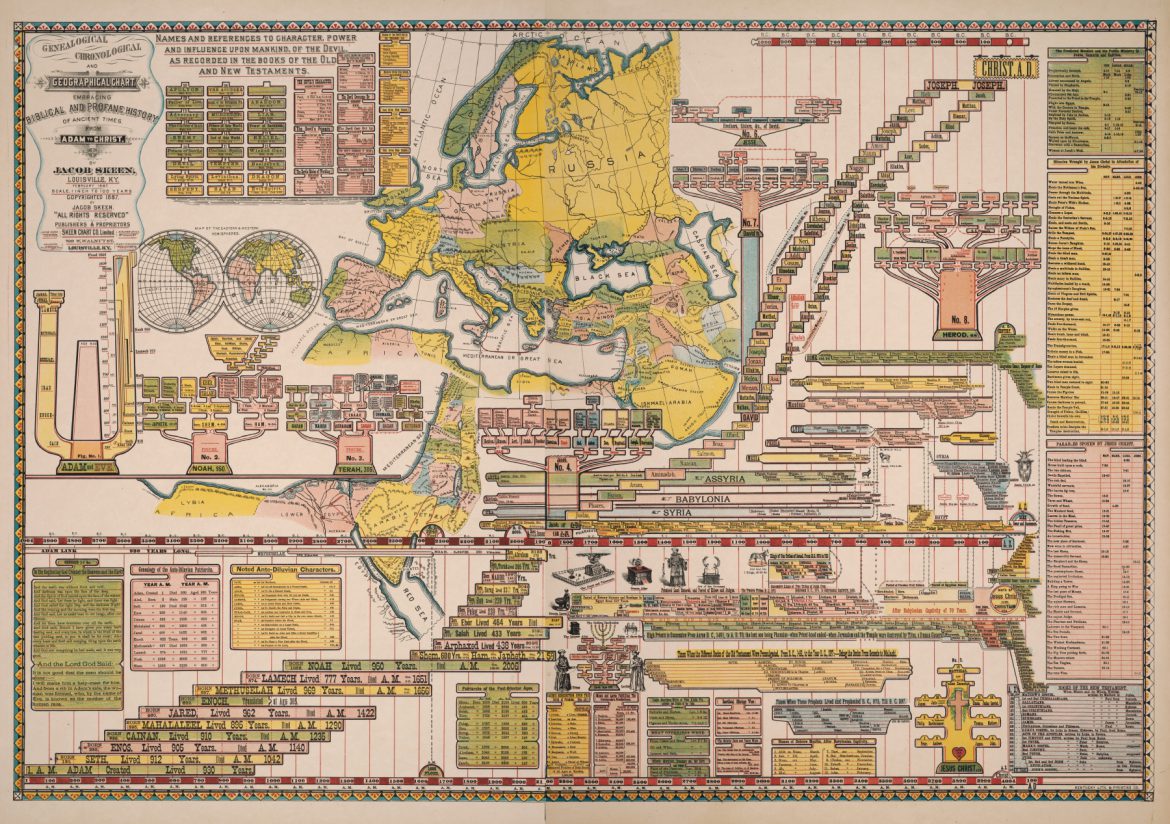
Genealogical, Chronological and Geographical Chart: Embracing Biblical and Profane History of Ancient Times from Adam to Christ by Jacob Skeen, The Skeen Chart Co., Louisville, KY, Lithographed by the Lithograph and Printing Company, Louisville, KY, Shaker Museum | Mount Lebanon: 2017.25.1a,b
An earlier blog examined one of the smallest publications done by the Shakers – The Little Instructor, printed by Elder Henry C. Blinn in 1849 at Canterbury, New Hampshire. On the other end of the spectrum, the Shakers were involved in publishing a piece measuring three by four feet. It is an 1887 lithographed chart created by Jacob […]
An earlier blog examined one of the smallest publications done by the Shakers – The Little Instructor, printed by Elder Henry C. Blinn in 1849 at Canterbury, New Hampshire. On the other end of the spectrum, the Shakers were involved in publishing a piece measuring three by four feet. It is an 1887 lithographed chart created by Jacob Skeen titled Genealogical, Chronological and Geographical Chart: Embracing Biblical and Profane History of Ancient Times from Adam to Christ.

Genealogical, Chronological and Geographical Chart: Embracing Biblical and Profane History of Ancient Times from Adam to Christ by Jacob Skeen, The Skeen Chart Co., Louisville, KY, Lithographed by the Lithograph and Printing Company, Louisville, KY, Shaker Museum | Mount Lebanon: 2017.25.1a,b
The great fire of 1875 at Mount Lebanon’s Church Family had repercussions that continued for years as the Shakers increased industries that would produce cash to help them recover from the loss. The best known and probably most lucrative of these efforts was the addition of a contract to manufacture medicine for Andrew Judson White. This work, like much that followed, depended on the well-organized, dedicated sisterhood of the family. Other industries that were taken on over the next decade included the manufacture of knitted gloves and mittens made from raccoon fur and silk and the manufacture of men’s neckties. As part of this effort, in February 1887 the Shakers began producing giant charts intended to educate children about the Bible.
The chart was the result of ten years work by Jacob Skeen, an industrialist – he created and operated the Louisville Crucible Steel Casting Company – turned Bible and ancient history scholar. Skeen researched, designed, and created the artwork for the chart. In partnership with his brother David Skeen, he was eventually able to enlist the Shakers at Mount Lebanon, New York (Brother Benjamin Gates), Union Village, Ohio (Elder Matthew B. Carter), and Pleasant Hill, Kentucky (Elder Francis M. and Brother William F. Pennybaker) in the project. The chart provided timelines showing major figures of the Bible and their family trees along with their geographical locations and major Biblical events including the creation of Adam and Eve, the birth of Christ, and a summary of Christ’s miracles and parables. It was the Shakers at the Church Family at Mount Lebanon who did the actual work to produce the charts – a perfect job for the sisters. With some assistance from Brother Andrew Fortier, Sister Cornelia French and several others set up the chart business in the south garret of the new Dwelling House. There they trimmed the massive color lithographs and pasted them to a cloth backing. In early April David Skeen came to Mount Lebanon and made a presentation about the charts to the Shakers in their meeting room. That month the Shakers shipped about 25 charts to New York City to be sold. Brother Alonzo Hollister made peddling trips with the charts. Sales must not have met expectations and in mid-October, Brother Benjamin traveled to Cincinnati to meet and consult with Elder Matthew Carter and William Pennybaker about them. Their desire was to convince Skeen to produce a smaller, cheaper chart. It is not clear how many charts were originally printed but the year-end summary of the Church Family sisters’ work noted that in 1887 they had pasted and trimmed 204 charts and the business was concluded that year. The fact that there are untrimmed, unpasted charts, such as the one in the Shaker Museum | Mount Lebanon collection, suggests more than 204 charts were printed.

Key of Explanation to Skeen’s Genealogical, Chronological and Geographical Chart, (cover) by Jacob Skeen, copyright 1886, The Skeen Chart Co., Louisville, KY, Lithographed by the Lithograph and Printing Company, Louisville, KY, Shaker Museum | Mount Lebanon: 1957.9516.1

Key of Explanation to Skeen’s Genealogical, Chronological and Geographical Chart, (back of title page) by Jacob Skeen, copyright 1886, The Skeen Chart Co., Louisville, KY, Lithographed by the Lithograph and Printing Company, Louisville, KY, Shaker Museum | Mount Lebanon: 1957.9516.1
While the charts are rare (the survival rate for something that large is usually small) even more scarce is a book the Skeens produced to accompany the chart. The book provides instructions on how to maximize the educational value of the chart and includes similar artwork. The book also supplies a little more information on the publication of Skeen’s charts. Although the charts are dated 1887, Skeen’s Key of Explanation contains nine testimonials – all but one from various Louisville, KY, churches – dated November 1886. It appears Skeen may have circulated the original drawing for the chart to garner testimonials prior to turning it over to the lithographers for publication in 1887. At this time only two copies of the book have been located in libraries – one at the Library of Congress and the other here at Shaker Museum | Mount Lebanon.
Much remains unknown about the relationship between the Skeen brothers and the Shakers, including how the Shakers came to be involved in this venture, how much their investment was in the business, and even whether the Shakers used the Bible charts in their own schools.